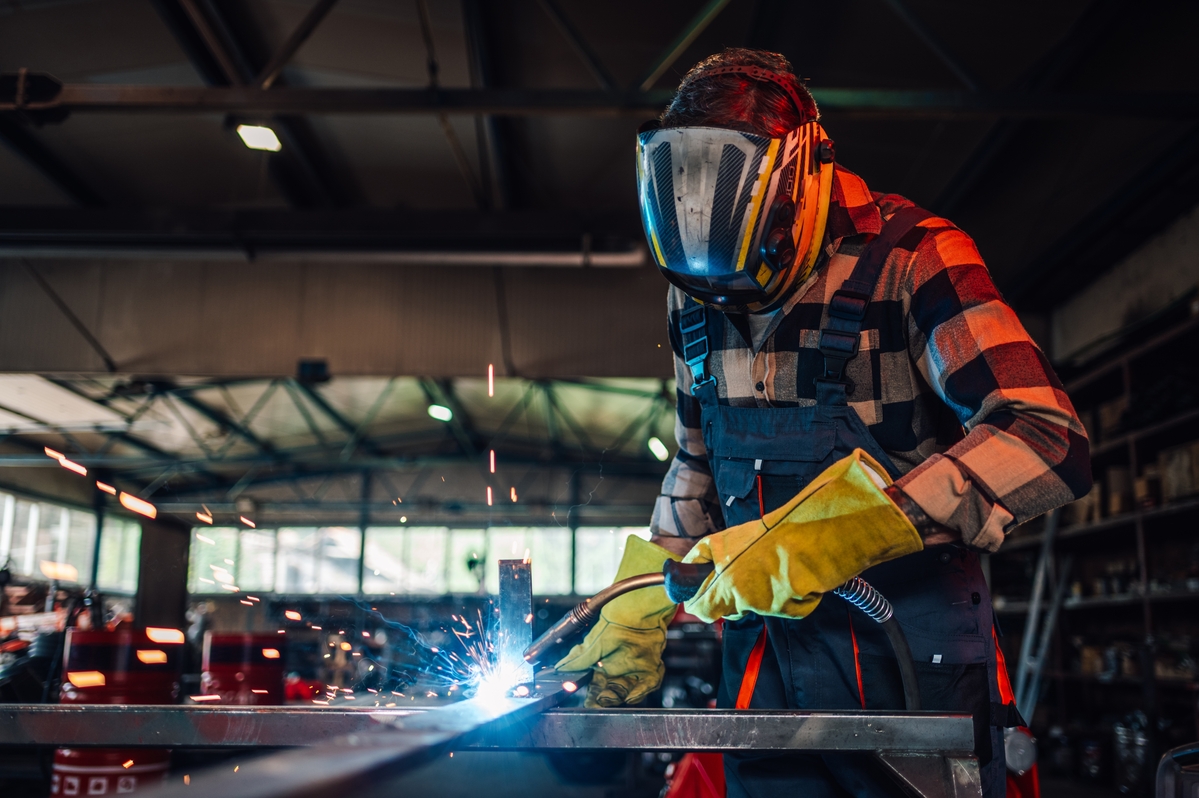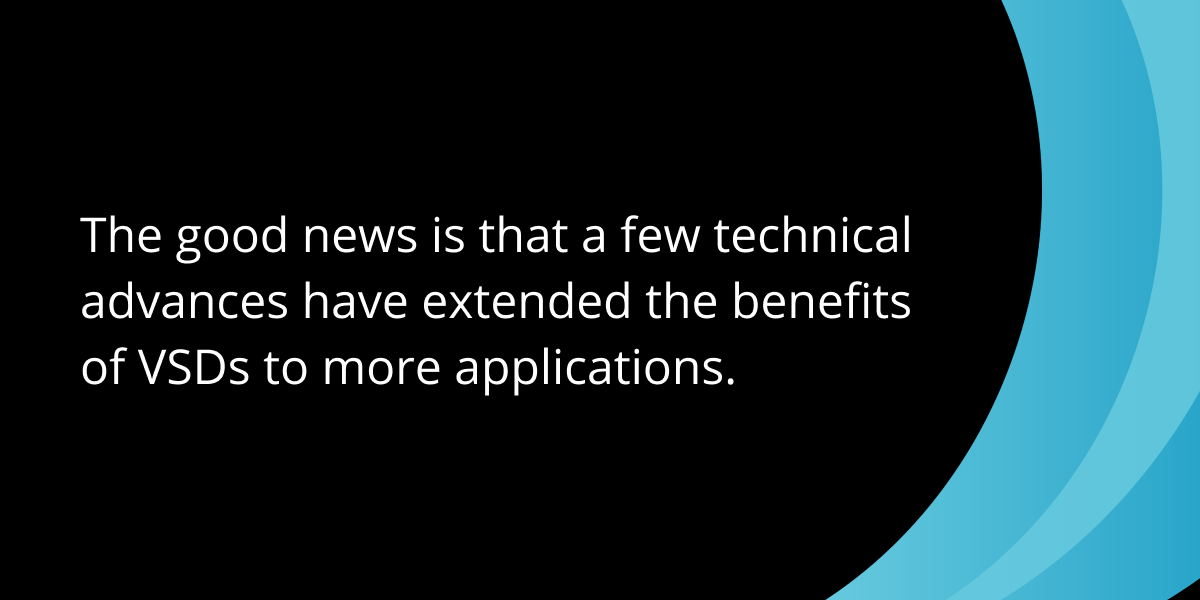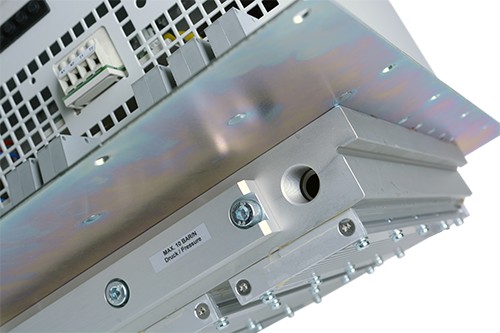
Four (and a Half) Critical Compressed Air Safety Tips
January 29, 2025
The Role of Air Compressor Intake Filters
February 12, 2025How Variable-Frequency-Drive Air Compressors Work
Kaishan USA | February 5, 2025| Uncategorized

Technology changes have made variable-frequency and variable-speed drives more attractive in industries like metalworking.
Variable frequency drives have become popular additions to rotary screw air compressors, leading to the rise of the VFD air compressor.
First, a word about terminology.
Difference Between VFD and VSD Compressor
There’s a lot of confusion about the terminology. Is it a variable-speed or variable-frequency drive? There is a difference.
However, it is relatively easy to distinguish between the two terms when you have one key piece of information: there are several ways to vary speed. The mining industry, for instance, uses variable voltage variable frequency drives, which change both the voltage and the frequency to control motor speed.
So, variable-frequency and VVVF drives are different ways to achieve the same result: operating a motor at variable speeds. Because VFDs and VVVF drives both do that, they are both VSDs. But, as we’ve seen, not all VSDs are VFDs.
Since the compressed air industry primarily uses VFDs, many systems refer to a variable frequency drive air compressor or a variable speed drive air compressor interchangeably. We will use both in this post.
VSDs and VFDs can save energy and money and boost performance. Here’s how.
How a Variable Frequency Compressor Works
A variable frequency drive compressor uses an electronic controller to adjust the frequency of the power supplied to your air compressor’s motor.
Based on input from sensors throughout your system, the VFD speeds up or slows down the motor to match the compressed air demand, delivering several significant benefits.

Facilities may benefit from using a VFD air compressor or variable frequency compressor if they have significant differences in compressed air demand between shifts.
Benefits of VSDs/VFDs
First, by reducing motor speed when demand is low, you save energy. The Compressed Air & Gas Institute estimates a VSD will reduce energy use by about 33%.
CAGI says you can keep the pressure band to +/- 1.5 PSIG with a variable-speed compressor.
Second, you’ll save money. A study by the American Society of Mechanical Engineers placed the average annual cost savings of VSD compressors at $17,208 with a two- to five-year payback. Plus, you may be able to qualify for rebates from state and local governments and utilities.
You can ramp up to full speed more gradually, avoiding the high in-rush current (six times as high as standard operating current) that fixed-speed compressors draw during startup. Thus, they reduce peak amps, avoiding utility company penalties for increased demand on the power grid. In general, you can match the demand profile as efficiently as possible.
They also help address rapid cycling, where your compressor is damaged by turning on and off too frequently. (For more information on this problem, see our blog post, “My Compressor is Rapid Cycling. Now What?“
We provide more detail on the benefits of VSDs and VFDs in our blog post, “The Benefits of Installing Variable-Speed Compressors.”

The good news is that a few technical advances have extended the benefits of VSDs to more applications. Let’s start with liquid-cooled VSDs.
Liquid-cooled VSDs
For many years, Kaishan did not recommend using VSDs in industrial environments where the air contained dust and dirt.
In a traditional VSD, airborne contaminants clog the VSD’s heat sink, causing it to overheat. That’s why we did not recommend installing VSDs where the unit would be near a welding operation, for example, which adds conductive material to the ambient air.
That has changed, however. Newer, liquid-cooled VSD drives can alleviate some of the problems associated with dust and dirt in the air.

Kaishan’s new liquid-cooled variable frequency drive air compressor can dissipate heat using water, glycol, or other appropriate coolant.
So, while a traditional VSD-driven air compressor can overheat when dust, dirt and airborne contaminants clog the drive’s heat sink and fans, newer VSDs will quickly remove the heat with a liquid-cooling system.
Other advantages of the liquid-cooled unit include:
- Temperature. A liquid-cooled VSD runs cooler due to the efficiency of heat removal. Operating electronics at lower temperatures is always preferred.
- Efficiency. Because a liquid-cooled VSD does not add as much heat to the environment, the compressor does not have to remove as much as it would with an air-cooled VSD, allowing the unit to run more efficiently.
- Smaller footprint. Depending on the manufacturer, the VSD may not require as much space in your machine.
Remote VSDs
Another option for extremely dirty environments is changing the VSD’s location. You could, for instance, locate a variable speed drive air compressor unit in a separate control room with cleaner air and cooler temperatures than adjacent manufacturing and production areas. More and more companies are creating these rooms to protect sensitive controls.
The distance between the VFD/VSD and the compressor should not exceed 50 feet because the various harmonic frequencies in the factory create too much interference at greater distances.


Variable-frequency and variable-speed drives, like those newly offered by Kaishan USA, allow rotary screw air compressors to operate more efficiently at part-load conditions. But they’re not for everyone.
Best Applications
A VFD compressor or variable frequency compressor delivers the greatest benefits when you have significant variation in demand.
They work best for uses between 30-70% of capacity in facilities with changes in demand between shifts or at different times of the year. VSDs are not recommended at capacities below 20% or above 80%.
Oil-Free Units
Because they have more significant heat-dissipation challenges, oil-free air rotary screw compressors have a more limited range for VSDs than oil-flooded units. Keeping an oil-free unit in the 60% range is preferable.
And while VSDs offer a wide range of benefits, there are some situations in which they are not the best solution.
When a VSD/VFD Is Not Recommended
You should probably avoid using a VFD air compressor or variable frequency compressor where you have:
- Little to no variation in demand
- An inconsistent power supply
- Excessive dirt, dust, moisture, heat or cold (unless you are using a liquid-cooled VSD instead of a traditional air-cooled VFD)
There are alternatives to VSDs, including modulation. You may also find a multiple-compressor strategy is a more effective solution, especially in providing backup during a compressor shutdown. For more on these VSD alternatives, see our blog post, “My Compressor is Rapid Cycling. Now What?"

If your company would benefit from adding a VSD or VFD air compressor, we recommend working with a compressed air professional.
Not a DIY Project
Unless you’re a controls engineer, you probably don’t want to take on a VSD installation as a do-it-yourself project. You will save yourself a lot of potential headaches by working with a qualified compressed air professional. And avoid some of the pitfalls that occur when VSDs or VFDs are not appropriate for your application.
We recommend you work with your local compressed air expert to specify, select and install a VSD air compressor.
Kaishan USA works with a nationwide network of independent distributors, who can provide on-site help and consultation as needed. These factory-trained air compression experts can audit your air compressor system and help you decide whether a VSD or VFD compressor would be an asset in your application.
Key Takeaways
- Variable-frequency drives have become popular additions to rotary screw air compressors for many reasons.
- A variable frequency drive is an electronic component that adjusts the frequency of the power supplied to your air compressor’s motor.
- First, by reducing motor speed when demand is low, VFDs/VSDs save energy.
- VSDs also save energy and qualify for state, local and utility company rebates.
- Newer, liquid-cooled VSD drives can alleviate some of the problems associated with dust and dirt in the air.
- Remote VSDs are another option for extremely dirty environments.
- VSDs and VFDs deliver the greatest benefits when you have 20-80% variation in demand or significant variation between shifts and seasons.
- You should avoid using a VFD/VSD where you have little to no variation in demand, an inconsistent power supply or dirt, dust, moisture, heat or cold more than what a liquid-cooled VSD could handle.
Let Us Help
Specifying and installing an air compressor with a VFD or VSD is critical to operating your compressed air system and all the processes that rely on that system. If you need help deciding whether a VSD is right for your application, get in touch with the experts at Kaishan. Contact us today.
Listen to the Podcast Version
Understanding Variable-Speed Drives (VSDs) in Air Compressors
Welcome back to the podcast! As always, we're grateful to spend some time with you.Alright, let's get straight into it. Variable-frequency drives, or VFDs, are game changers when it comes to air compressors. They're these electronic components that, basically, control the frequency of the power your motor gets. And why does that matter? Well, it lets the motor adjust its speed to match the demand for compressed air, instead of running at full tilt all the time.
Okay, so you're saying it's not just about turning the motor on or off, but customizing the speed to save energy, right?
Exactly. And the savings aren’t just theoretical. The Compressed Air Gas Institute estimates a VFD can cut energy use by about thirty-three percent. That’s a big deal when you're looking at industrial operations where energy consumption is no joke.
Wow, thirty-three percent. That’s not just a drop in the bucket—it's a real shift in efficiency. But are there specific situations where VFDs work best?
Yeah, there are. They're most efficient when you're running at about thirty to seventy percent of the compressor’s capacity. Think about plants with shifts where air demand changes—maybe it's heavier during the day and lighter at night, or it fluctuates seasonally. That’s when VFDs shine. Outside that range, like if you're running above eighty percent or below twenty, a fixed-speed compressor might actually make more sense.
So, it’s not one-size-fits-all. You really have to match the technology to the profile of your specific operation. Makes sense. But what about environments that might not seem ideal, like ones with a lot of dust or dirt? Isn’t that usually tough for these systems to handle?
Good question. That used to be a big limitation. Traditional VSDs would overheat in those conditions because their heat sinks would get clogged. But tech has caught up. The newer liquid-cooled VSDs solve a lot of these problems. They use liquid—like water or glycol—to dissipate heat instead of fans and heat sinks. So now, even in dusty or dirty environments, you can keep those systems running smoothly.
Ah, that’s a game changer. And I imagine they’re also more compact, right? Since you’re not relying on all that bulky air-cooling hardware?
Exactly. Smaller footprint, better temperature management, and improved efficiency overall. It’s not perfect for every setup, but for places that struggled to use VSDs before, this makes a huge difference.
Okay, so in the right conditions—variable demand, cleaner tech for tougher environments—these VSDs aren’t just efficient. They’re solving problems that would’ve been deal breakers in the past. That’s pretty exciting.
It is. And we’re just scratching the surface of what they can do.
Financial Impacts and Long-Term Savings of VSDs
Alright, Jason, you’ve sold me on the efficiency side of things, but let’s get down to dollars and cents. We’ve talked about energy savings, but how does that actually show up in a budget? Are we looking at real financial gains, or just nice numbers on paper?It’s definitely not just theoretical. Look, an average operation sees about seventeen thousand dollars a year in savings just by switching to a VSD system. And studies show the payback period is typically somewhere between two to five years. Think about that—after that time frame, it’s like putting seventeen grand straight back into your pocket. Every year.
Seventeen thousand? That’s serious money. And that’s just from reducing energy use, right?
Partly. It’s also about avoiding penalties. With traditional compressors, you get those high in-rush currents whenever the system starts up. It's like a massive energy spike—six times the normal operating current—and utility companies really ding you for that. VFDs ramp up much more gradually, so you’re not throwing money away paying for those demand surges.
Okay, so they’re saving energy, cutting penalties… but what about environments that are, let’s say, a little less than spotless? Any success stories there?
Actually, yeah. I came across a case where a facility in a dusty manufacturing environment started using liquid-cooled VSDs. Before, their air-cooled systems kept overheating because dirt and contaminants would clog up the heat sinks. But with the liquid cooling, that issue was pretty much eliminated. They switched to a liquid-based system, and it was able to keep running even with all the airborne dust.
That’s impressive. Did they see the same cost benefits as cleaner facilities?
Absolutely. They had that same two-to-five-year payback period, and they reduced the system downtime they had from overheating—a bonus that saved them even more in the long run.
So, even in places where VSDs used to struggle, the newer ones are holding their own. That’s pretty convincing—financial savings, fewer penalties, and now adaptability for tougher setups.
Right. These advancements make a huge difference for industries that couldn’t even consider VSDs before.
When VSDs Work Best (And Their Limitations)
It sounds like VSDs are solving challenges left and right. So, let’s talk next steps—if someone’s ready to install one, what do they need to know about getting it set up?The big one? Keep the VSD within fifty feet of the compressor. Anything beyond that, and you run into interference issues because of the harmonic frequencies in the factory. If you try to stretch it further, it’s like adding static to a radio signal—things just don’t work right.
Got it. So, you’re saying placement isn’t just about convenience—it’s about performance too. What about the environment itself? Can these systems handle messy, dusty conditions?
That’s where modern tech steps in. Traditional VSDs struggled because dirt and debris would clog up the heat sinks, leading to overheating. But with the liquid-cooled systems we’ve been talking about, that’s no longer an issue. They use liquid—like water or glycol—to manage heat, so they stay cool even in rough environments.
And for places that can’t install liquid-cooled systems? Are there other workarounds?
Well, yeah. You can use remote setups—put the VSD in a clean, temperature-controlled room away from the manufacturing floor. That way, the sensitive components stay protected, but you’ll need to keep it within that fifty-foot range I mentioned earlier. It’s a balance.
Interesting. But let’s say a plant has steady air demand—no shifts, no seasonal fluctuations. Are VSDs still the best option there?
Not really. In those cases, a fixed-speed compressor might be a better fit. It’s more efficient when demand stays constant, and you avoid the extra upfront costs of a VSD system. Alternatively, plants could look at strategies like modulation or even using multiple compressors to manage load more effectively. It’s about matching the solution to the problem.
So, it really comes down to understanding your specific needs. VSDs aren’t a magic bullet—they’re a tool that works best in the right settings.
Exactly. You’ve gotta think about your demand profile, your environment, and your long-term goals. When all those factors align, VSDs can transform how you manage compressed air systems. But if they don’t, it’s better to explore other options that might save you both time and money.
This has been such a solid conversation—learning not just the capabilities of VSDs but also their practical limits and where they really shine.
Yeah, it’s all about picking the right tool for the job. And like we’ve said, the tech is advancing, making VSDs more accessible for all kinds of industries. But it always comes back to understanding your unique setup.
Right, and on that note, I think we’ve covered a lot of ground today. Thanks for walking us through it all, Jason.
Of course. And to all our listeners, thanks for tuning in. If you’ve got questions about how this might fit your operation, reach out. Until next time, take care.
Random stat or
customer quote
textXXtext
text

